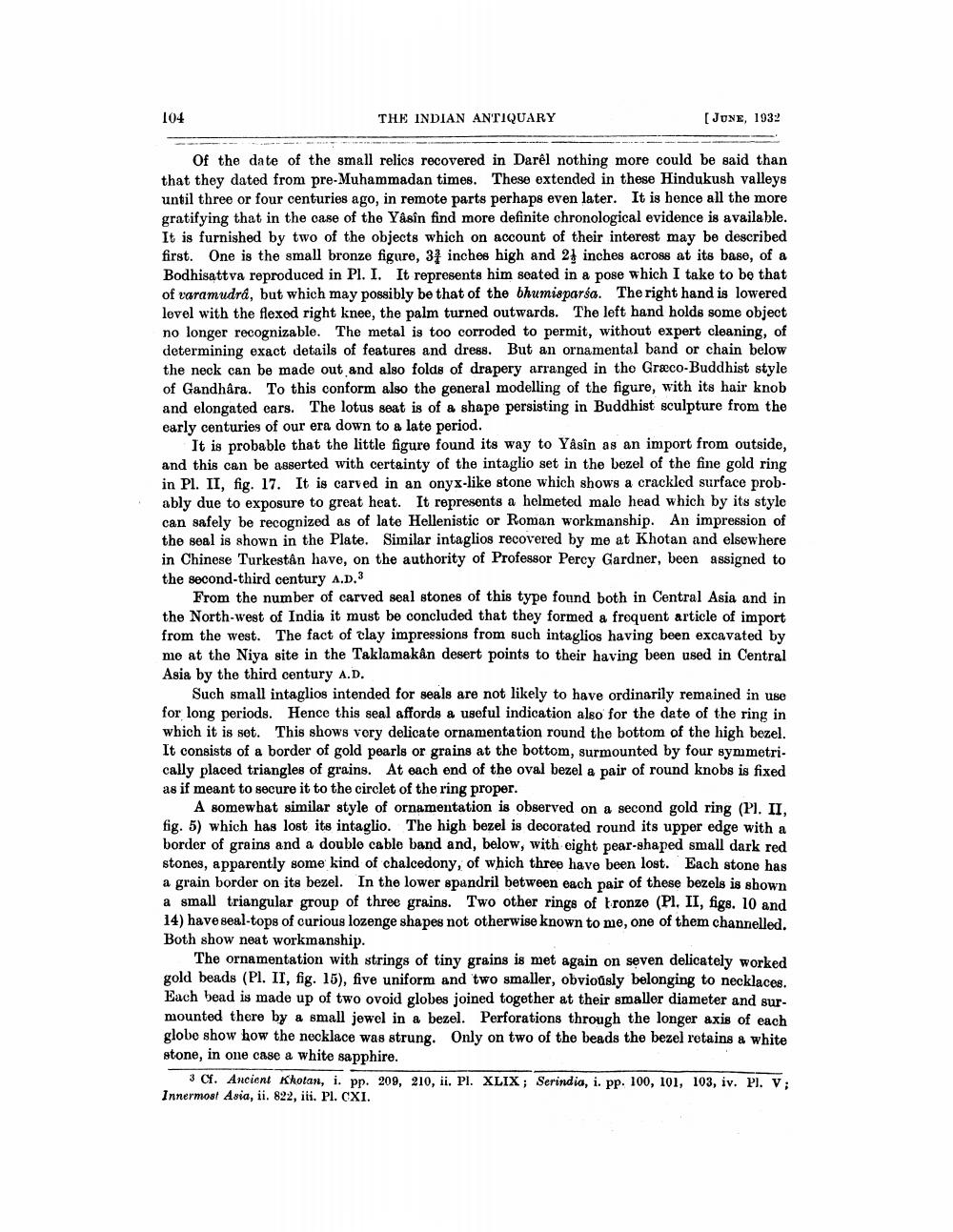________________
104
THE INDIAN ANTIQUARY
[JUNE, 1932
Of the date of the small relics recovered in Darel nothing more could be said than that they dated from pre-Muhammadan times. These extended in these Hindukush valleys until three or four centuries ago, in remote parts perhaps even later. It is hence all the more gratifying that in the case of the Yâsîn find more definite chronological evidence is available. It is furnished by two of the objects which on account of their interest may be described first. One is the small bronze figure, 34 inches high and 2 inches across at its base, of a Bodhisattva reproduced in Pl. I. It represents him seated in a pose which I take to be that of varamudra, but which may possibly be that of the bhumisparsa. The right hand is lowered level with the flexod right knee, the palm turned outwards. The left hand holds some object no longer recognizable. The metal is too corroded to permit, without expert cleaning, of determining exact details of features and dress. But an ornamental band or chain below the neck can be made out and also folds of drapery arranged in the Græco-Buddhist style of Gandhára. To this conform also the general modelling of the figure, with its hair knob and elongated ears. The lotus seat is of a shape persisting in Buddhist sculpture from the early centuries of our era down to a late period.
It is probable that the little figure found its way to Yâsîn as an import from outside, and this can be asserted with certainty of the intaglio set in the bezel of the fine gold ring in Pl. II, fig. 17. It is carved in an onyx-like stone which shows a crackled surface probably due to exposure to great heat. It represents a helmeted male head which by its style can safely be recognized as of late Hellenistic or Roman workmanship. An impression of the seal is shown in the Plate. Similar intaglios recovered by me at Khotan and elsewhere in Chinese Turkestån have, on the authority of Professor Percy Gardner, been assigned to the second third century A.D.3
From the number of carved seal stones of this type found both in Central Asia and in the North-West of India it must be concluded that they formed a frequent article of import from the west. The fact of clay impressions from such intaglios having been excavated by me at the Niya site in the Taklamakan desert points to their having been used in Central Asia by the third century A.D.
Such small intaglios intended for seals are not likely to have ordinarily remained in use for long periods. Hence this seal affords a useful indication also for the date of the ring in which it is set. This shows very delicate ornamentation round the bottom of the high bezel. It consists of a border of gold pearls or grains at the bottom, surmounted by four symmetri. cally placed triangles of grains. At each end of the oval bezel a pair of round knobs is fixed as if meant to secure it to the circlet of the ring proper.
A somewhat similar style of ornamentation is observed on a second gold ring (Pl. II, fig. 5) which has lost its intaglio. The high bezel is decorated round its upper edge with a border of grains and a double cable band and, below, with eight pear-shaped small dark red stones, apparently some kind of chalcedony, of which three have been lost. Each stone has a grain border on its bezel. In the lower spandril between each pair of these bezels is shown a small triangular group of three grains. Two other rings of kronze (PI, II, figs. 10 and 14) have seal-tops of curious lozenge shapes not otherwise known to me, one of them channelled. Both show neat workmanship.
The ornamentation with strings of tiny grains is met again on seven delicately worked gold beads (Pl. II, fig. 15), five uniform and two smaller, obviously belonging to necklaces. Each bead is made up of two ovoid globes joined together at their smaller diameter and surmounted there by a small jewel in a bezel. Perforations through the longer axis of each globe show how the necklace was strung. Only on two of the beads the bezel retains a white stone, in one case a white sapphire.
3 C4. Ancient Kkotan, i. pp. 209, 210, ii. Pl. XLIX; Serindia, i. pp. 100, 101, 103, iv. Pl. V; Innermost Asia, ii. 822, iii. Pl. CXI.




